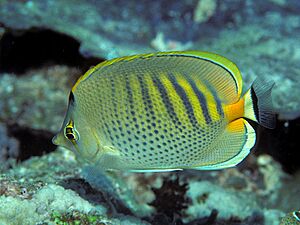Spotband butterflyfish facts for kids
Quick facts for kids Spotband butterflyfish |
|
|---|---|
 |
|
| Conservation status | |
| Scientific classification | |
| Genus: |
Chaetodon
|
| Species: |
punctatofasciatus
|
| Synonyms | |
|
Chaetodon punctatolineatus Gronow, 1854 |
|
The spot-banded butterflyfish (Chaetodon punctatofasciatus) is a beautiful fish. It lives in the ocean. This fish is a type of butterflyfish. It belongs to the Chaetodontidae family. You can find it in the western Pacific Ocean.
Contents
What is a Spot-Banded Butterflyfish?
The spot-banded butterflyfish is a small, colorful fish. It is a species of ray-finned fish. This means it has fins supported by bony rays. It is known for its unique patterns.
How Big Do They Get?
This butterflyfish can grow up to 12 centimeters (about 4.7 inches) long. That's about the length of a small ruler!
What Do They Look Like?
The body of the spot-banded butterflyfish is pale grey. It has many small grey spots. These spots form vertical bands on its upper sides. They also form horizontal rows on its lower sides.
The top fin, called the dorsal fin, has a yellow edge. There is also a bright orange patch. This patch runs through the part of its body where the tail connects. This area is called the caudal peduncle.
Where Do Spot-Banded Butterflyfish Live?
These fish live in the Indo-Pacific region. You can find them from Christmas Island in the Indian Ocean. They also live near the Line Islands. They are found north to the Ryukyu Islands and south to the Great Barrier Reef. They also live all over Micronesia.
Their Ocean Home
Spot-banded butterflyfish like clear waters. They live in areas with lots of coral. You can find them in reefs that face the open ocean. They also live in calm lagoon reefs.
What Do Spot-Banded Butterflyfish Eat?
These fish are busy eaters. They feed on tiny algae. Algae are like small water plants. They also eat coral polyps. Coral polyps are the tiny animals that build coral reefs. They also eat other small creatures. These creatures live on the ocean floor. They are called benthic invertebrates.


